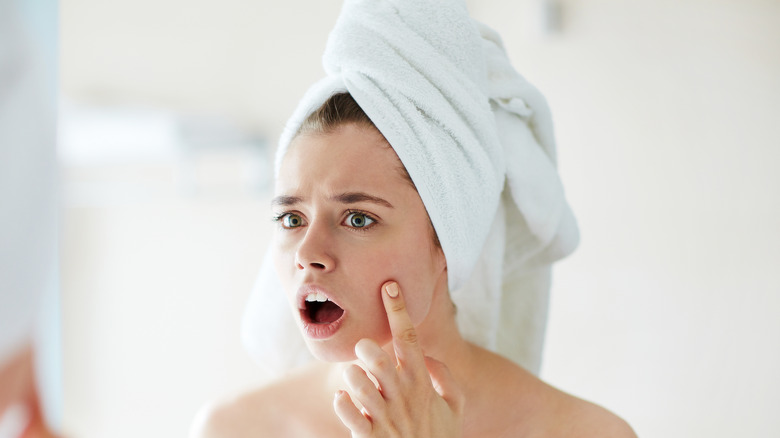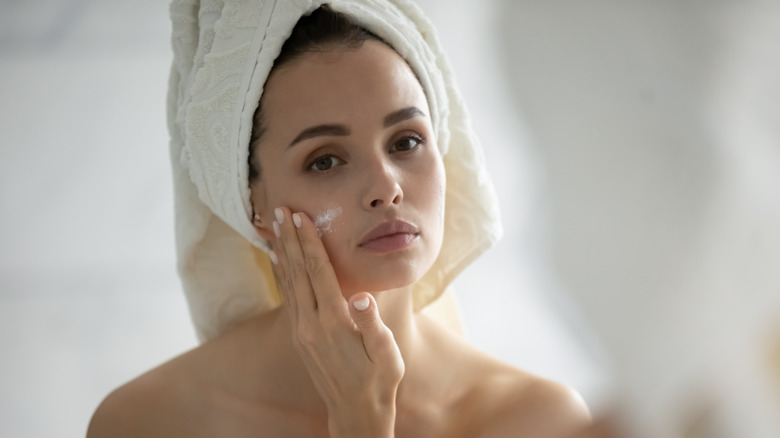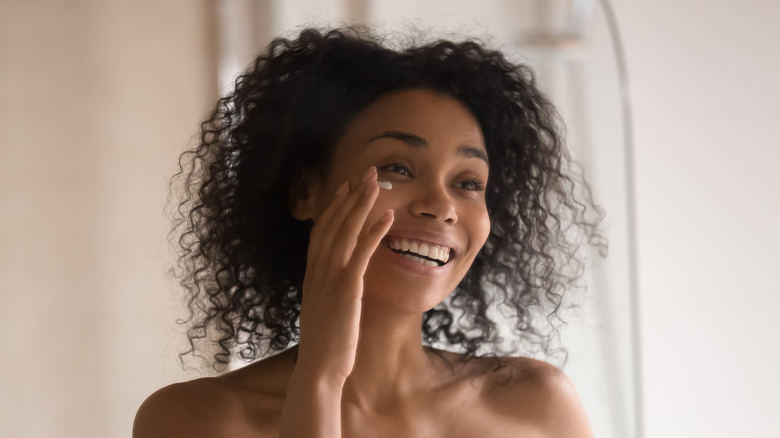How To Sync Your Skincare Routine To Your Menstrual Cycle
It always starts the same way. You look in the mirror and notice a pimple that seems to have popped up out of the blue. You start calculating the date of your last period and draw in a deep breath as the realization sinks in. It's almost time for another round with Aunt Flo.
For many people who menstruate, an acne breakout is the first sign their period is on the horizon. It can come before the irritability, mood swings, period cramps, and the other multitude of PMS symptoms. Premenstrual acne breakouts are a common period woe. A study conducted in 2014 found that 65% women agreed that their acne worsened with menses. Similar to many premenstrual symptoms, acne breakouts are a result of normal hormonal fluctuations.
Speaking to Self, S. Manjula Jegasothy, a board-certified dermatologist, explained why acne worsens as your period arrives, "The hormones that cause this type of acne are fluctuations of estrogen and progesterone, which both vary widely throughout the menstrual cycle." She added, "It is believed that hormonal fluctuations, which can be menstrual or cyclical (or both) in women, do cause increased oil production in the pore." According to Curology, progesterone, in particular, contributes to greater sebum production by stimulating the sebaceous glands. The excessive oil production caused by the sebaceous glands clogs your pores and leads to acne. You can potentially break the cycle of acne breakouts around your period by tailoring your skincare routine to the phase of the menstrual cycle you're in.
There are four phases in the menstrual cycle
Ironically enough, the first stage of the cycle begins when we'd think it ends, the menstruation — AKA the bleeding stage. During this stage, your skin might be as irritated as your mind is when you deal with all the typical period symptoms. For this stage, you want to keep things simple and stick to what works for you.
Dr. Rebecca Booth, an OB-GYN, explained to Huda Beauty that during the first three days of your cycle, estrogen, progesterone, and testosterone plummet to their lowest. This can cause your skin to feel dry, dull, irritated, and sensitive, per consultant dermatologist Dr. Mary Sommerlad via Marie Clare. To combat this icky "period skin" feeling as we commonly know it, Dr. Sommerlad recommends using gentle and hydrating skincare products that don't contain any irritants which might aggravate your sensitive skin.
Once the bleeding ends, the follicular phase begins. During this stage, your skin will feel and look better than ever and you have the estrogen surge to thank for this. As a pharmaceutical scientist and beauty content creator, Hannah English explained to Youtime, "Estrogen helps to plump the skin, hydrate it, and increase collagen production. So it should be looking plump, calm, radiant." She recommended letting your skin continue to thrive on its own and following your normal skincare routine. Focus on maintaining your skin and feel free to experiment with new products whilst your skin can entertain them.
Taking good care of your skin during phase three and four is vital
The third phase — AKA ovulation — is in the middle of your cycle and is where you can make or break things. It begins around 14 days before the start of your period. During the start, the scales are still tipped in your favor because your estrogen levels are still optimal. As per Flo, five days into your ovulation phase, you'll likely feel your skin get oily because of the increasing progesterone levels and decreasing testosterone and oestrogen levels. Now's the time to jump into action with some good skincare to keep your acne in check.
You want to keep your pores free from oil build-ups that cause acne, and exfoliation is your best bet for that, per Camille Styles. Youtime recommends switching to non-comedogenic, lightweight skincare products because the heavier creams might cause pore buildups that may worsen your skin's oil problems.
And finally, we have the luteal phase, or the pre-menstruation stage. It's sad, but you have to watch your estrogen glow fade away as the levels decrease. As Dr. Anthony Rossi, a board-certified dermatologist, explained to Real Simple, "As estrogen drops, the premenstrual phase usually leads to acne due to the rise in progesterone. When progesterone is high, it causes [the] skin to swell, so one may experience inflammatory acne papules and pustules." Clean Beauty School advises using soothing products like gentle cleansers and niacinamide (B3) serum that calm your inflamed skin while eliminating the excess oil.


